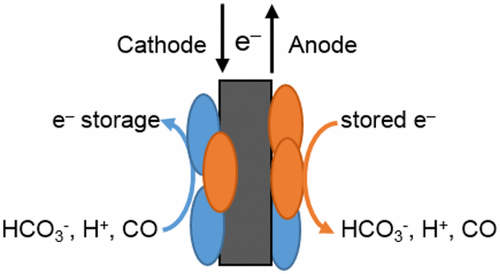当前位置:
X-MOL 学术
›
Environ. Sci. Technol. Lett.
›
论文详情
Our official English website, www.x-mol.net, welcomes your feedback! (Note: you will need to create a separate account there.)
Microbial Electrochemical Energy Storage and Recovery in a Combined Electrotrophic and Electrogenic Biofilm
Environmental Science & Technology Letters ( IF 10.9 ) Pub Date : 2017-08-25 00:00:00 , DOI: 10.1021/acs.estlett.7b00335 Matthew D. Yates 1 , Li Ma 2 , Joshua Sack 3 , Joel P. Golden 1 , Sarah M. Strycharz-Glaven 1 , Scott R. Yates 2 , Leonard M. Tender 1
Environmental Science & Technology Letters ( IF 10.9 ) Pub Date : 2017-08-25 00:00:00 , DOI: 10.1021/acs.estlett.7b00335 Matthew D. Yates 1 , Li Ma 2 , Joshua Sack 3 , Joel P. Golden 1 , Sarah M. Strycharz-Glaven 1 , Scott R. Yates 2 , Leonard M. Tender 1
Affiliation

|
Here we report enrichment from a marine-derived inoculum of a nonphotosynthetic electroactive biofilm that is capable of both consuming electricity (electrotrophy) and producing electricity (electrogenesis) from a single electrode. With the alternation of the electrode potential between −0.4 and 0.0 VSHE every 10 min, alternating anodic and cathodic currents increased in lock step (maximum current density of ±1.4 ± 0.4 A/m2 in both modes, Coulombic efficiency of ∼98% per charge–discharge cycle), which is consistent with alternating between generation and consumption of energy storage compounds by the biofilm. Cyclic voltammetry exhibited a single sigmoid-shaped feature spanning anodic and cathodic limiting currents centered at −0.15 VSHE, a phenomenon not observed to date for an electroactive biofilm, and square wave voltammetry exhibited reversible peaks at −0.15 and −0.05 VSHE, suggesting the same redox cofactor(s) facilitates electron transport at the biofilm–electrode interface in both modes. Hydrogen and carbon monoxide, known energy and/or carbon sources for cellular metabolism, but no volatile fatty acids, were detected in reactors. Cells and cell clusters were spread across the electrode surface, as seen by confocal microscopy. These results suggest that a single microbial electrochemical biofilm can alternate between storing energy and generating power, furthering the potential applicability of bioelectrochemical systems.
中文翻译:

结合电营养和电生物膜的微生物电化学能量存储和回收
在这里,我们报告从非光合电活性生物膜的海洋来源接种物中富集,该生物膜既可以消耗电(电养分),又可以从单个电极产生电(电发生)。每隔10分钟在-0.4至0.0 V SHE之间改变电极电位,则在锁定步骤中增加阳极和阴极交流电流(两种模式下的最大电流密度为±1.4±0.4 A / m 2,库仑效率约为98%每个充放电循环),这与生物膜储能化合物的产生和消耗之间的交替是一致的。循环伏安法显示出一个单一的S型曲线特征,跨越以-0.15 V SHE为中心的阳极和阴极极限电流,至今仍未观察到电活性生物膜的现象,方波伏安法在-0.15和-0.05 V SHE处显示可逆峰,表明在两种模式下相同的氧化还原辅助因子都有助于电子在生物膜-电极界面的传输。在反应器中未检测到氢和一氧化碳,它们是细胞代谢的已知能源和/或碳源,但未检测到挥发性脂肪酸。通过共聚焦显微镜观察,细胞和细胞簇遍布电极表面。这些结果表明,单个微生物电化学生物膜可以在能量存储和发电之间交替,从而进一步提高了生物电化学系统的潜在适用性。
更新日期:2017-08-26
中文翻译:

结合电营养和电生物膜的微生物电化学能量存储和回收
在这里,我们报告从非光合电活性生物膜的海洋来源接种物中富集,该生物膜既可以消耗电(电养分),又可以从单个电极产生电(电发生)。每隔10分钟在-0.4至0.0 V SHE之间改变电极电位,则在锁定步骤中增加阳极和阴极交流电流(两种模式下的最大电流密度为±1.4±0.4 A / m 2,库仑效率约为98%每个充放电循环),这与生物膜储能化合物的产生和消耗之间的交替是一致的。循环伏安法显示出一个单一的S型曲线特征,跨越以-0.15 V SHE为中心的阳极和阴极极限电流,至今仍未观察到电活性生物膜的现象,方波伏安法在-0.15和-0.05 V SHE处显示可逆峰,表明在两种模式下相同的氧化还原辅助因子都有助于电子在生物膜-电极界面的传输。在反应器中未检测到氢和一氧化碳,它们是细胞代谢的已知能源和/或碳源,但未检测到挥发性脂肪酸。通过共聚焦显微镜观察,细胞和细胞簇遍布电极表面。这些结果表明,单个微生物电化学生物膜可以在能量存储和发电之间交替,从而进一步提高了生物电化学系统的潜在适用性。



























 京公网安备 11010802027423号
京公网安备 11010802027423号